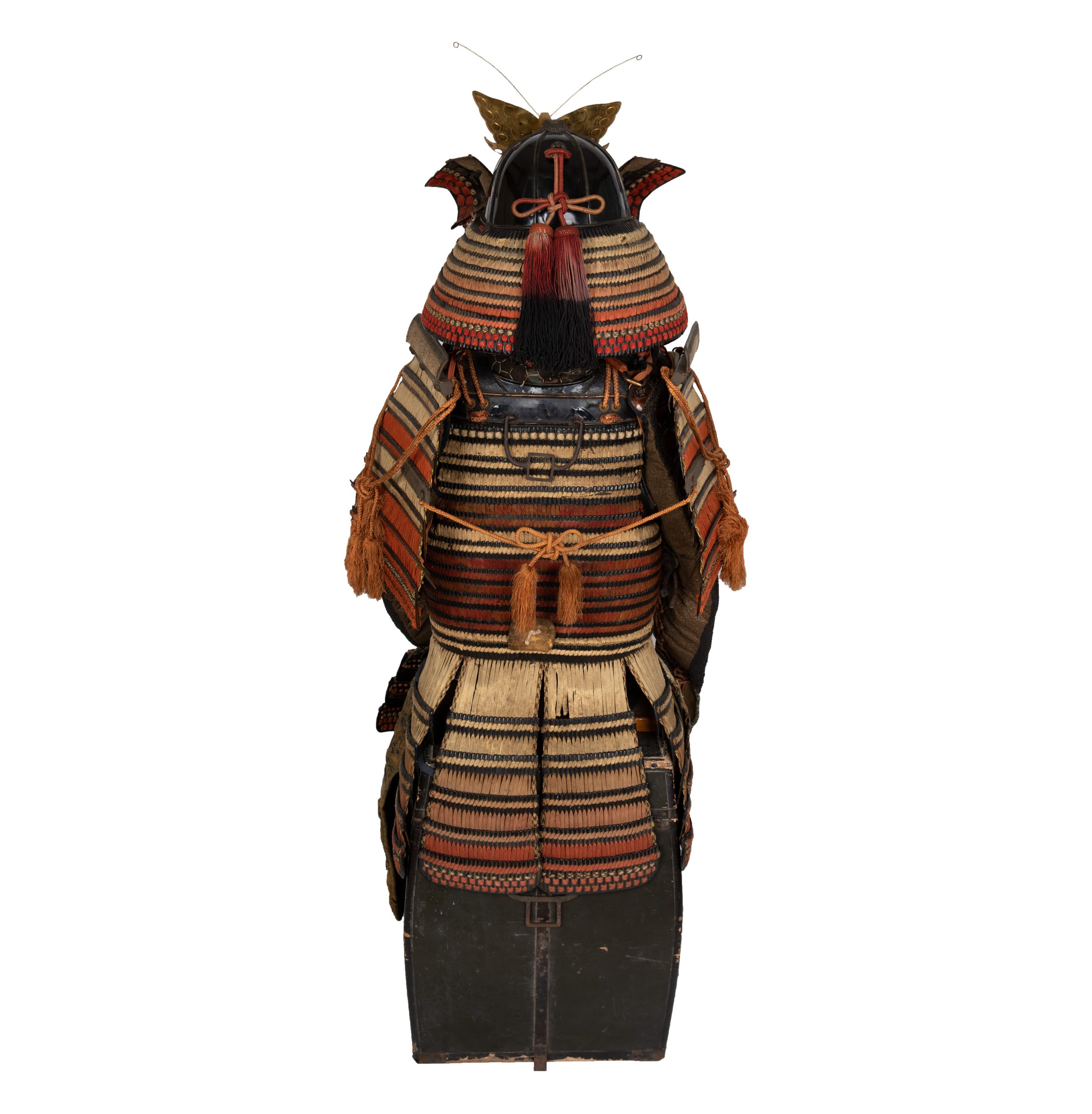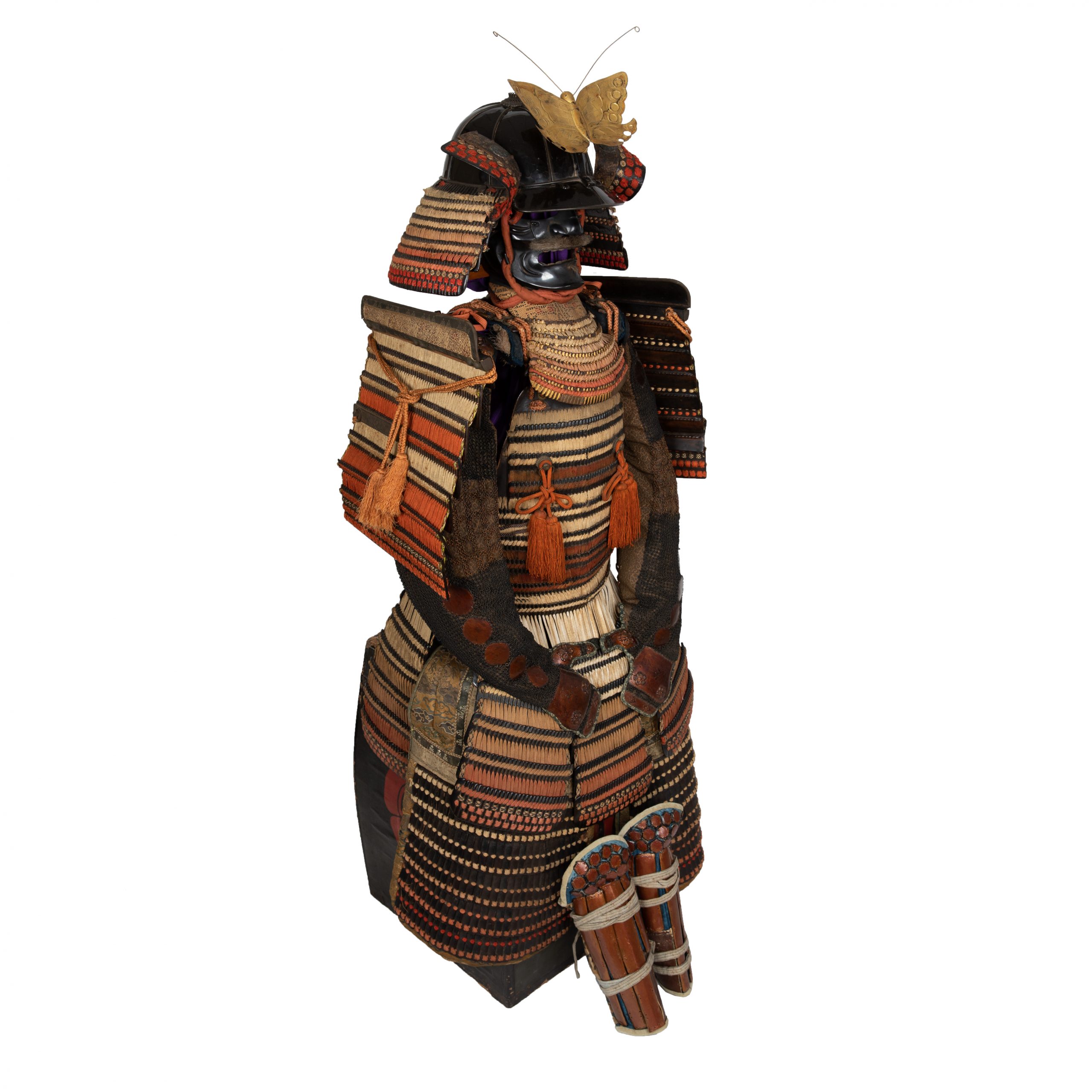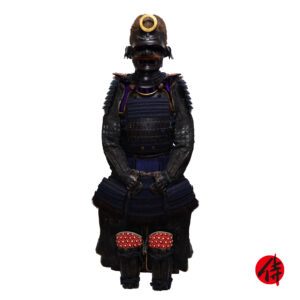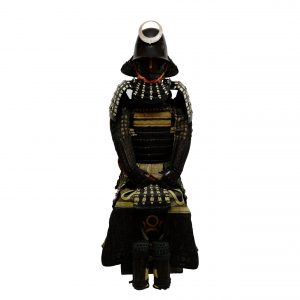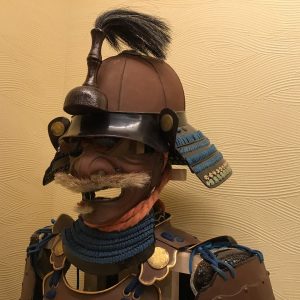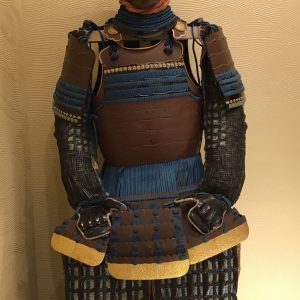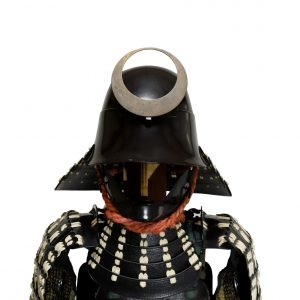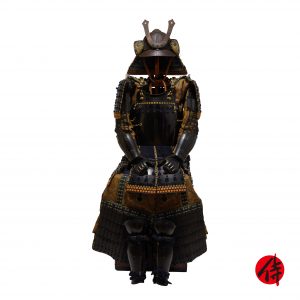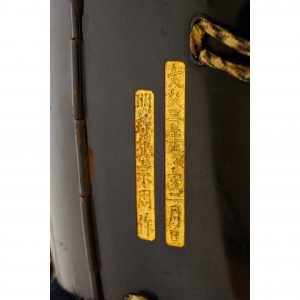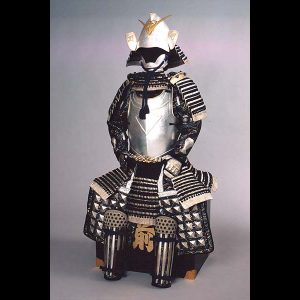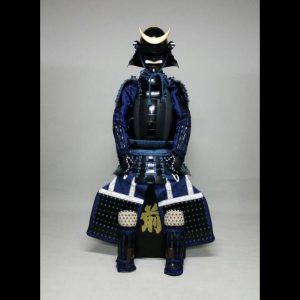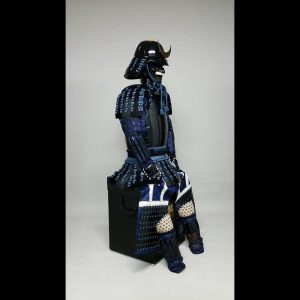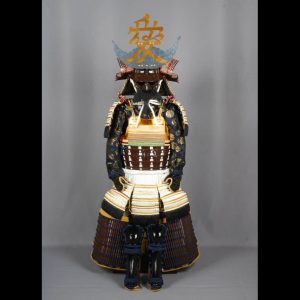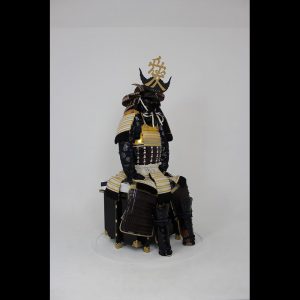Antique Edo Period O-Sode Samurai Armor Tokubetsu Kicho Shiryo Certificate (A-16)
Period: Mid Edo Period (late 17th- early 18th century)
appraised by The Association for the Research and Preservation of Japanese Helmets and Armor

Kabuto (helmet)
■Helmet bowl:
The Kabuto (兜, helmet) is a protector for the head. When people started using the Kabuto, it was initially designed for practical use. However, the principal purpose of its design has changed with time; Samurai tried to express their dignity, personality, or religion by wearing the characteristic designed Kabutos. According to a theory, these unique designed Kabutos were made from the late Muromachi period to the Edo period. This type of Kabuto is categorized as the Kawari Kabuto (変わり兜), and a variety of materials were used to create them. For example, animal fur, seashells, plants, and papers were used as materials for decoration.
Here we would like to introduce to you a little bit more about the history of Kabutos. Before the Kawari Kabuto’s production, the Suji Kabuto (筋兜) has appeared during the Nanbokuchou (南北朝, 1337-1392) period. At that time, the tactic was gradually changed from the piggyback fight style to battle with the Tachi (太刀) sword and the Naginata (薙刀, Japanese halberd) on the ground. Therefore, there was a rise in demand for the weight saving of the Kabuto. Also, in order to turn the attack by swords, a new type of structure was invented; it is the Suji Kabuto (筋兜). Its form slides swords’ attacks when weapons hit the Kabuto. It is said that the production of the Suji Kabuto prospered in the Muromachi (室町, 1336-1573) period. This helmet has eight plates and it is called Hakken Suji Kabuto. It is coated with black lacquer (Kuro Urushi Nuri).

■Shikoro (side neck guard):
Iron plates laced with ivory and orange threads.

■Fukikaeshi (side neck guard): Yukiwa-ni Tachi Omodaka Mon
The Fukikaeshi (吹き返し) is both ends of a helmet. It protects the face from swords and also shows its beautiful workmanship. Family crests are sometimes designed on this part, as seen in this work. You would find a plant crest on the Fukikaeshi part. This design is called the Yukiwa-ni Tachi Omodaka (雪輪に立ち沢瀉) pattern, which is a type of Omodaka (沢瀉) pattern. The Yukiwa (雪輪) is snow ring. This snow ring is the outline of this family crest. The Omodaka (沢瀉) is a plant. Its name was compared to another ward Omodaka (面高), which means save face/ keep honor. Also, as its leaf looks similar to an arrowhead (the arrow was once the primary weapon for Samurais), this plant was called the Kachi-Gusa (勝ち草, winning leaf). Based on these things, the Omodaka motif was appreciated among Samurais, and they used it for their family crests.
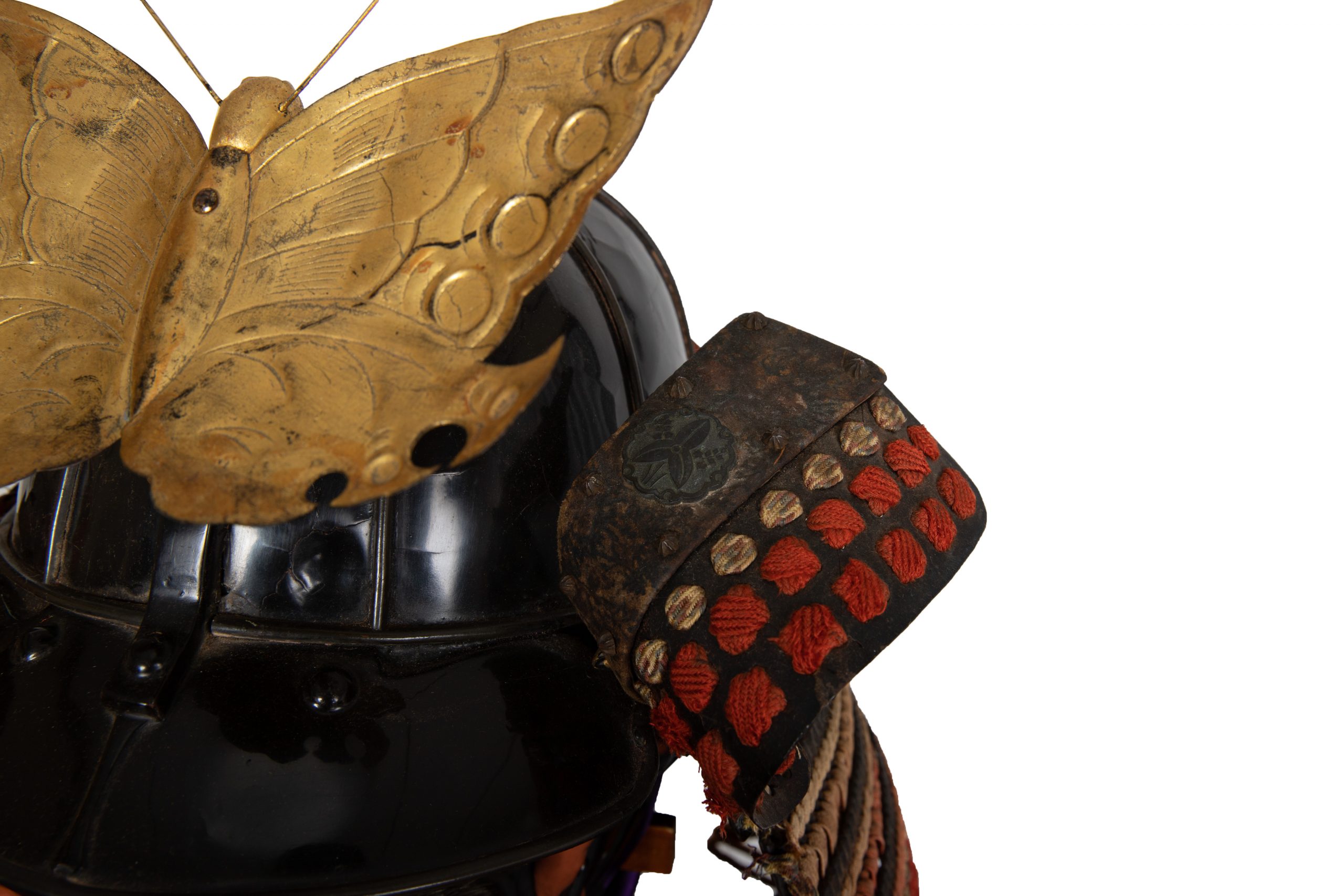
■Menpo (face guard):
Iron mask with a mustache. This type of Menpo is called Retsusei Menpo (烈勢面頬). It represents the angry face to intimidate enemies.
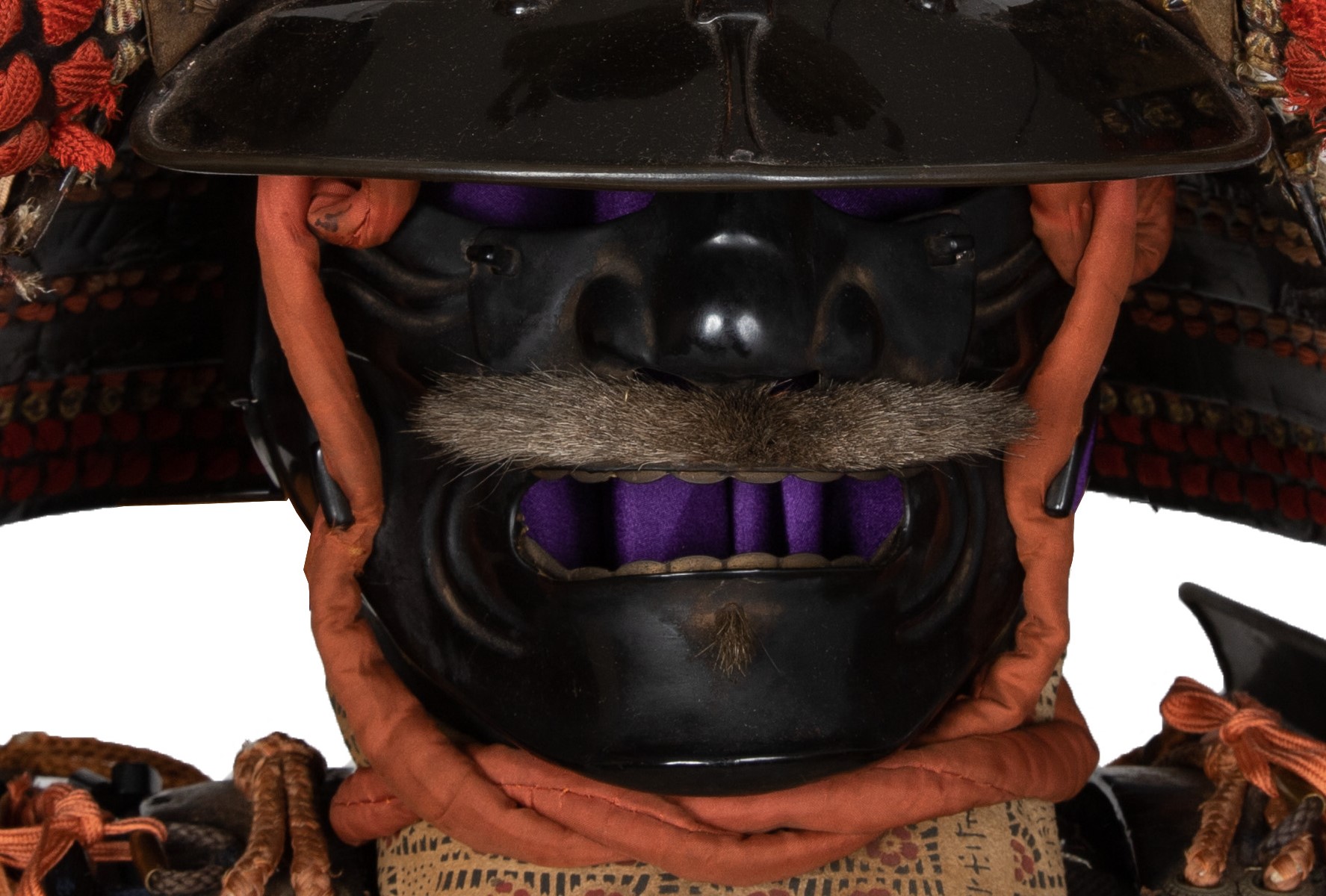
■ Maedate (Front decoration): butterfly
The Maedatemono (前立物, front decoration) is attached to this helmet. In this work, the motif of Maetate is a Chou (蝶, butterfly). The design is the majestic appearance of a butterfly with its wings spread. A larva becomes a chrysalis, and it grows up into a butterfly. As this insect changes its looks, it symbolizes the reborn. It is understandable that Samurais, who are always on the verge of life and death, loved the butterfly pattern.

Armor
■Do (cuirass): Nimai Do
The Nimai Do (二枚胴) is a kind of cuirass for Tousei Gusoku (当世具足, developed armor style). Since Nimai (二枚) means two plates, and Do (胴) means torso in Japanese, this type of Do is called this name. This Do uses many small lamellar plates called Kozane (小札, small strip-shaped plate).
The body armor part can be separated into two pieces and connected with a hinge. Typically, the hinge is located on the left side, and you can tighten this cuirass on the right side. This Do is made of black lacquered iron plates, and these were laced with navy blue thread.
■Sode (shoulder guards):
Iron Sode (袖) laced with ivory and orange threads. This armor has Ō-Sode (大袖) type shoulder guard, which is usually attached to an Ō-Yoroi (大鎧). In Japan, horse-riding warriors attacked enemies on horseback with both hands, such as bows and swords. The cavalry warriors protected themselves by twisting their bodies and being attacked by enemy arrows with these large sleeve protectors. They used the Ō-Sode as an alternative to a shield held in one hand.

■Kusazuri (skirt of plates attached to the cuirass):
Lacquered iron Kusazuri laced with ivory and orange threads.

Small parts
■Kote (armored sleeves):
Intricate iron chain mail with silk.


■Haidate (thigh protection):
The Haidate (佩楯) is a thigh guard.
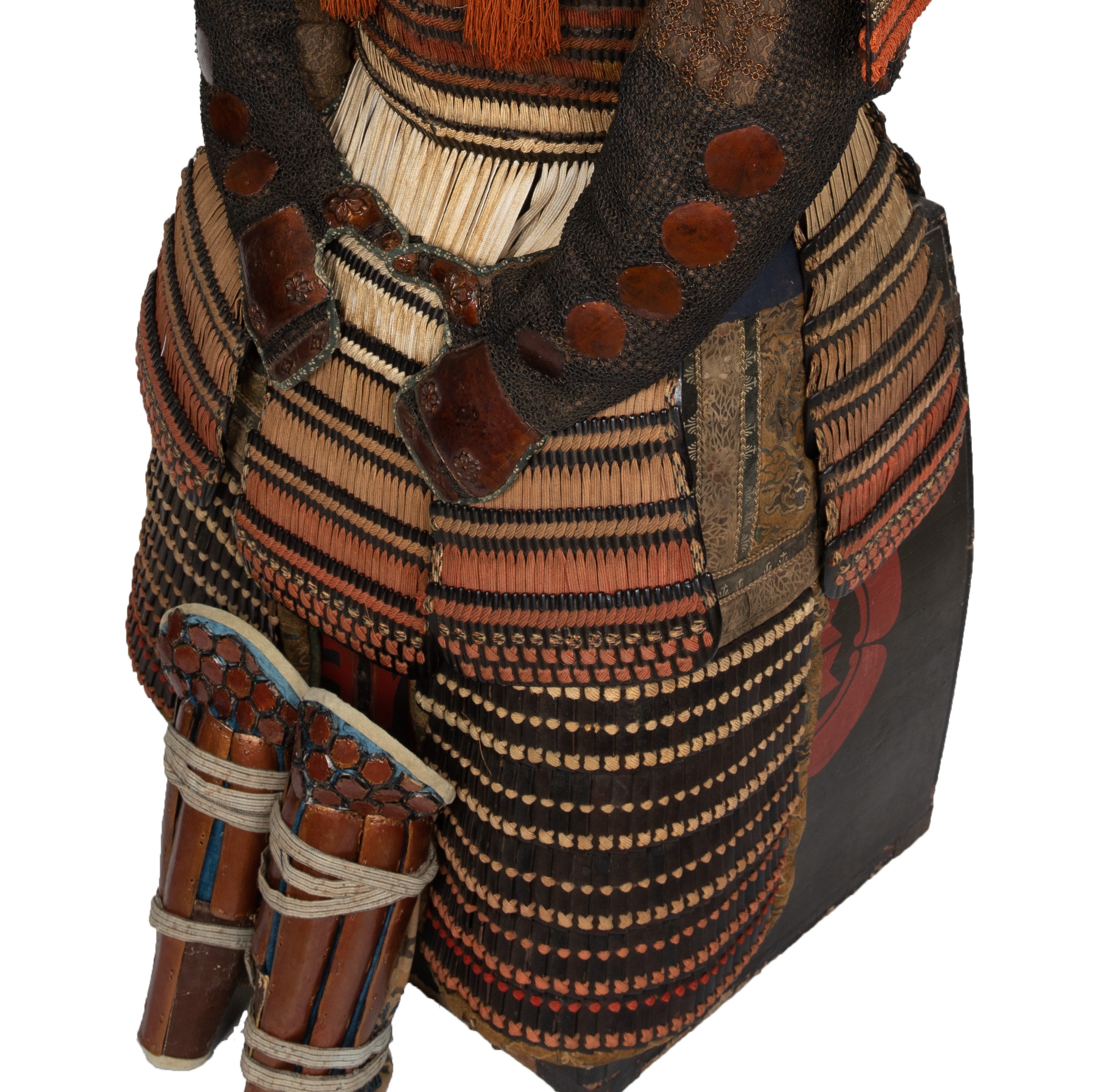
■Suneate (shin guard):
Metal shin guard. Hexagonal metal plates are chained together and create a pattern that resembles a turtle shell. This design is called the Kikkou (亀甲, turtle’s shell) pattern. It is a continuous geometric pattern connecting regular hexagons up and down. A theory says that this design was brought from the Continent during the Asuka (592-710) and Nara (710-794) periods. A proverb says turtles live long lives; therefore, turtle and turtle’s shell pattern represent longevity. In addition, as this continuous hexagonal pattern does not get out of its shape, it is said that people wished for eternal prosperity by using this design.

■Kacchu-Hitsu (armor box):
You would find a red-colored mark on the side of this armor box. We think it is designed as a family crest, which is categorized as a type of the Mokkou (木瓜) pattern. According to a theory, this motif represents the prosperity of future generations. There are a variety of kinds of Mokkou designs, and many families use one of them. The famous Samurai, Oda Nobunaga (織田 信長, 1534-1582) also used the Mokkou pattern for his crest and is called the Oda Mokkou (織田木瓜).

Certification: Tokubetsu Kicho Shiryo Certificate (No. 1984)
On November 6th 2022, this armor was appraised as a Tokubetsu Kicho Shiryo by The Association for the Research and Preservation of Japanese Helmets and Armor, which is the most trusted Japanese armor appraiser in Japan. Tokubestu Kicho Shiryo means special rare article. It is ranked as the third highest of five rankings.
The paper mentions the armor was made in the mid Edo period (late 17th- early 18th century). You can receive this original authentication paper.
An English translation of the certificate is available on request. We won’t charge any additional fee.

【About us】
Samurai Museum is located in Tokyo, Japan, exhibiting antique artifacts related to the Samurai history. Samurai Museum Shop is the place for those who are interested in Japanese culture and craftsmanship. We deal with antique Samurai swords/armor, traditional crafts made in Japan and so on.
【Antique Japanese Armor and Export process】
After receiving the full payment from you, we will apply for its export permit from the agency for Cultural Affairs to legally export the antique Samurai armor to other countries. It normally takes around 2-4 weeks to receive this permit. And we would like you to expect at least 1-1.5 months for your order to arrive at your given address after you ordered.
【Payment method】
We accept payment through Stripe (Credit card), PayPal, Apple Pay or ChromePay, all of which are secure payment methods. Also, you don’t need to make an account on Stripe for the checkout. If you prefer other payment method, please contact us. You may either pay in JPY, USD, AUD, CAD, EUR, CHF or GBP. The price is set in Japanese Yen. Prices in other currencies are automatically calculated based on the latest exchange rate.

【Shipping duration】
We normally ship via EMS (Express Mail Service) provided by Japan Post. It usually takes at least 5-14 days to deliver the package after you place an order. We offer Free International Shipping as long as we can ship your order by EMS. If you prefer other shipping carriers, please contact us.
We will inform you of the order’s tracking number via email. Please make sure you fill out your valid email address correctly.
*Please keep in mind that due to the spread of COVID-19, there might be possible delays in delivery. If you like to make sure if EMS shipping is available to your country, please contact us.

【How to make sure the condition】
Please keep in mind that what you are going to purchase is an antique item. We uploaded high resolution photos for you to check its condition thoroughly. If you like to see more photos with different angles, please feel free to contact us. We will be happy to send them to you so that you can make informed decision. It is essential for us to know that you are happy with your choice of a sword. and we are prepared to use the best of our ability to serve you.
【How To Contact Us】
Please contact us through email, Facebook Messenger or Live Chat if you have any questions. You can find each icon on the right side of the website. Please click one of them to reach us. We will reply to you within 1-2 business days.
【How To Preserve Antique Samurai Armor】
Dryness, humidity, and bad ventilation might deteriorate the condition of antique Samurai armor. The best temperature to preserve Samurai armor is around 20℃ in Celsius, and humidity should be about 60%. Direct sunlight should be avoided. We recommend storing armors in a room with good ventilation. If you like to display them outside the boxes for a prolonged time, we suggest using a glass case in order for dust not to be accumulated easily. In case you don’t use a glass case, please make sure to regularly dust off from the armor by using a soft brush made of delicate cloth or brush for painting.
If you like to know more about the preservation of this armor, please feel free to contact us.



